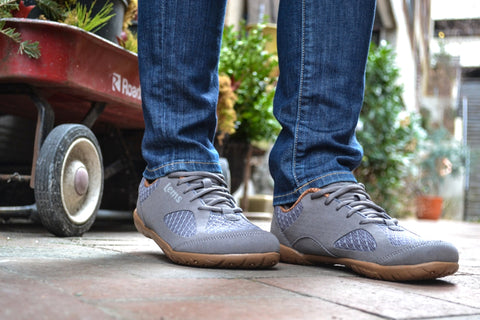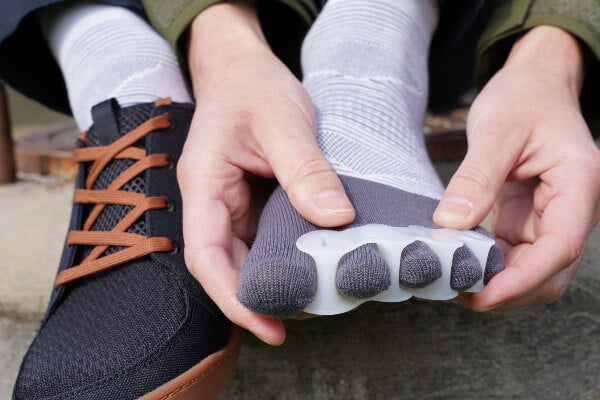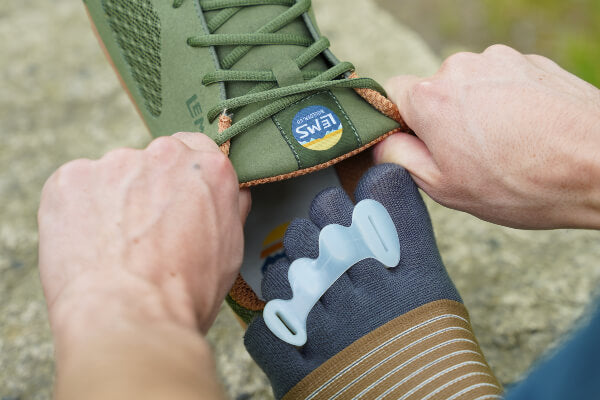The Shoe Cushioning Myth

For decades, we, as footwear consumers and users, have been told that we need plenty of padding in our shoes and under our feet to help boost... Read more

This is an article I co-wrote with sports podiatrist and Correct Toes inventor Dr. Ray McClanahan.
Here’s a common scenario some of you may find yourself in: It’s been a few months since you last pulled on your athletic shoes, and you’ve been wearing conventional shoes at work that meet the office dress code but are kind of constricting. There is a big annual walking or running event coming up in the not-too-distant future that you always participate in, or you’ve recently discovered a new event or a long hike that you’re just dying to try. But you’ve got a nagging foot problem and you’re wondering if you can begin your training. Or perhaps a new problem has cropped up seemingly out of nowhere. If this is the situation you find yourself in, this article is for you!

The question at the heart of this discussion is: “When is it appropriate for me to begin training in earnest for a walking event or multi-day hike if I have a foot problem that is causing me pain or discomfort?” As fellow runners and walkers, we understand the urgency that comes with preparing for a big race, event, or outing, and we also understand how frustrating it is to wait out a foot problem before ramping up training volume and intensity (or even to miss an event due to a foot problem or injury). We’ve been there, and we sympathize with your situation. But trying to train with an existing foot problem is not an appropriate course of action, as it usually ends up compounding the problem and leading to a more deeply entrenched foot issue.

The pain or discomfort associated with plantar fasciosis (commonly mislabeled “plantar fasciitis”), neuromas, bunions, capsulitis, sesamoiditis, and other foot problems is your body’s way of telling you that something is wrong and needs to be corrected. Perhaps it’s an impediment to natural foot health that needs to be removed (think conventional footwear) or a longstanding foot or lower extremity issue that was never properly addressed. Whatever the issue, it’s important that it gets resolved before you start any serious weight-bearing exercise routine. We know this may sound unappealing, but don’t despair, as there is every reason to believe that your foot issue can be helped in a timely manner, if you allow your foot to function the way nature intended.

The answer to most common foot problems, including the ones that keep you from participating in the activities you love, is elegantly simple and universally applicable. The first step in restoring natural foot health is understanding which specific shoe features deform your natural foot shape and alter the dynamics of your feet and toes. Heel elevation, toe spring, toe box taper, and rigid soles are all injurious design elements found in most conventional footwear. Excessive cushioning, excessive weight, and things such as built-in “arch support” are also problematic inclusions to watch for and avoid in all types of footwear, including athletic footwear. Using shoes that are truly foot-healthy—flat from heel to toe, flexible in the sole, and widest at the ends of your toes—allows your feet and toes the freedom to act as nature planned.
SHOP MEN'S SHOES SHOP WOMEN'S SHOES

Many people also benefit from using Correct Toes toe spacers to realign their toes to the splayed position commonly seen in the healthiest feet in the world—the feet of barefoot or unshod populations in Africa, Asia, South America, and elsewhere. Injinji toe socks and Pedag metatarsal pads or Strutz Pro foot pads can also be very helpful in enabling optimal foot form and function, overcoming a variety of longstanding foot and toe problems, and preventing the kinds of problems that might limit your athletic participation. Performing key stretching and strengthening exercises and incorporating the use of BlackBoard training tools into your foot care routine are two additional important strategies for building strong, healthy, and resilient feet.
SHOP CORRECT TOES SHOP INJINJI TOE SOCKS SHOP PEDAG METATARSAL PADS SHOP STRUTZ PRO FOOT PADS SHOP BLACKBOARD TRAINING TOOLS
Many people find that their foot pain or problem dissipates once the barriers to natural foot health are removed and proper toe alignment and foot position is restored. How quickly this occurs depends on numerous factors, though, including the tissue types involved (e.g., nerve, muscle, tendon, ligament, etc), the mobility/plasticity of the involved tissues or structures, and how long you’ve been experiencing the problem. Most people will experience at least some degree of immediate relief from their foot pain or problem after adopting foot-health-promoting footgear and performing the helpful exercises mentioned above, with additional beneficial results occurring over several weeks and months, assuming good compliance.

Some light training may be appropriate during the initial recovery phase, as long as your foot pain or discomfort is not made worse with weight-bearing activity or does not alter your gait. Compensating for a foot injury by changing your gait can lead to problems in other parts of your musculoskeletal system (e.g., knees, hips, back, etc.) and further downtime away from your passion. If you are limping, have severe pain, or if your pain increases as you walk or run, you should avoid walking, running, and hiking. Consider getting on your bike or into the pool for your workout instead, all the while seeking the help of an appropriate healthcare provider to solve the underlying foot problem so that you can get back to your weight-bearing activities as quickly as possible.

Performing a clear-eyed assessment of your readiness for physical activity is an important thing to do if you've been away from athletic participation for some time. This assessment, in our opinion, should incorporate a close inspection of your foot health and function and how you can best support your feet—the foundation of your entire body. Regardless of your current situation (free of foot pain or currently experiencing foot pain or problems) we encourage you to carefully consider your footwear and how it can help or hinder your foot health and quality of life. Consider, too, the many potential benefits of adopting footgear, such as Correct Toes, that gently encourages your foot to become strong on its own.
Every set of feet is unique, and an approach that works great for one person may not work as well for someone else. For this reason, as well as to learn more about noninvasive methods for treating and preventing common foot problems, we encourage you to meet with a naturally-minded podiatrist or other foot care expert in your area if you're encountering difficulties in your transition back to an active lifestyle.
We wish you many miles of happy, pain-free running and walking!
Disclaimer:
The above content is for educational or informational purposes only and is not intended to replace or augment professional medical instruction, diagnosis, or treatment. Read full disclaimer here.$65.00
$65.00
$10.00
$35.00
$102.00
$35.00
$35.00
$30.00
$120.00
$120.00

For decades, we, as footwear consumers and users, have been told that we need plenty of padding in our shoes and under our feet to help boost... Read more

Many people are aware that a transition period is required when switching from conventional shoes to minimalist shoes (now... Read more


I’ve been wearing “minimalist shoes” nearly full-time for almost two years, and going barefoot indoors, as well as brief excursions on rough pavement and forgiving round gravel.
In that time, I’ve never been able to go more than about 3 miles walk/jogging in Vibram FFs or Xeros at a single go… while my commute is a bit over five miles… so I end up carrying “regular” sneaks and socks and switching into them when the pain gets really bothersome. But other than that, it hasn’t been bad, and progress – though slow – has been happening.
But then I had a couple or three months without the commute and got soft. To resume, I tried a much shorter “minimalist” portion on alternate days with cycling in between. In just over a week, I’ve got miserable plantar fasciitis/fasciosis. The pad of my right forefoot is puffy, tender, and spends a lot of time just hurtin’. Did I mention that I stand at work, almost exclusively? But some of the worst pain is in bed, in the middle of the night.
Anyway, I think a salient couple of points are that:
a) I noticed the first real pain after CYCLING
b) Because the foot problem won’t let me walk/jog the commute… that leaves …. yes… cycling.
I don’t have bindings and cycling shoes; I have running shoes or minimalist shoes. As I’ve been forced to think about the situation, it seems that cycling makes the problem worse, because my foot and calf stay engaged in that extended position (ball of foot working the pedal) for the whole trip, because of the soft soles.
I’d hate to have to buy stiff-soled, narrow (… my feet have widened), constricting, dedicated cycling shoes, as well as the binding-style pedals to go with them, just for a few weeks.
So, where do I go from here?
How does one keep a semblance of conditioning when one can’t go any distance on foot, and cycling seems to be part of the problem?
Obviously, I got on this rant after reading what you said about replacing walking/running with cycling to get through foot injuries.
Kevin, in Ottawa, Canada, eh?
Greetings, Kevin,
Thank you for your comment. You make some excellent points, and I appreciate how frustrating it can be to be unable to commute (by foot or by bike) due to foot pain. The first order of business, I think, is to address your current plantar fascia pain. I suspect that you may already have visited our plantar fasciosis page (www.naturalfootgear.com/blogs/education/17889104-plantar-fasciosis), but we also have another page on our site that talks about the underlying cause of this common foot problem (www.naturalfootgear.com/blogs/education/17889940-plantar-fasciosis-the-underlying-cause).
As unintuitive as it may seem, manually restoring the big toe to its normal anatomical position (i.e., in line with the first metatarsal bone and the inside edge of the foot) is absolutely crucial in treating and preventing plantar fascia pain in most cases (as it removes pressure on the blood vessels that cleanse the plantar fascia of metabolic byproducts and debris). Consistent Correct Toes use (www.naturalfootgear.com/products/correct-toes) is the best way we know to do this.
These simple stretches and exercises, especially the Big Toe Stretch, may also prove beneficial in restoring the health of your plantar fascia and rehabilitating your feet (www.naturalfootgear.com/blogs/education/17915320-top-exercises-for-feet-toes). Note: You can perform the Big Toe Stretch on both toes simultaneously by looping a thick elastic band over each of your big toes and gently stretching your feet apart.
Until your plantar fascia pain resolves, it may be best to avoid any activities that would aggravate the problem (including running or cycling, in your case). In terms of cycling contributing to your current foot pain/problem, what shoes are you cycling in? If your cycling shoes have any of these problematic shoe design features (www.naturalfootgear.com/blogs/education/17890808-problematic-shoe-design-features), this may be contributing to your plantar fascia pain on the bike. Note: flexible vs. non-flexible soles are probably not a huge factor here).
Going with a pair of conventional cycling shoes isn’t going to help much, as these shoes are notoriously unhealthy for feet. There are few good options for a foot-healthy cycling shoe (yet), but we’ve put together this article that offers some suggestions on how to modify dedicated cycling shoes for foot and toe health and comfort (www.naturalfootgear.com/blogs/education/17861648-cycling-shoe-surgery).
You had mentioned that you’re on your feet almost constantly while at work. What kind of footwear do you typically wear while at work? If you’re wearing more conventional type footwear for most of your work day, it may be possible that any beneficial effects of the minimalist footwear you were wearing is being negated. I’m not sure what your work environment is like, but we do offer some dress shoes and casual shoes that may be helpful (www.naturalfootgear.com/collections/mens-shoes). A lot of people who spend most of their work day on their feet (nurses, servers, hair dressers, etc.) have benefited greatly from these shoes (especially when used in combination with Correct Toes).
In terms of building or retaining conditioning until your foot problem resolves, the pool is always an option. Swimming and other aquatic activities can be a great way to maintain fitness levels without exacerbating existing foot problems. Mixing in a little strength training is another option, as is participating in gyrotonics, yoga, and other movement arts (e.g., tai chi, qi gong, other martial arts).
Thanks again for your question, Kevin! Please do let me know if you have any additional comments or questions.
Kind regards,
Marty Hughes, DC